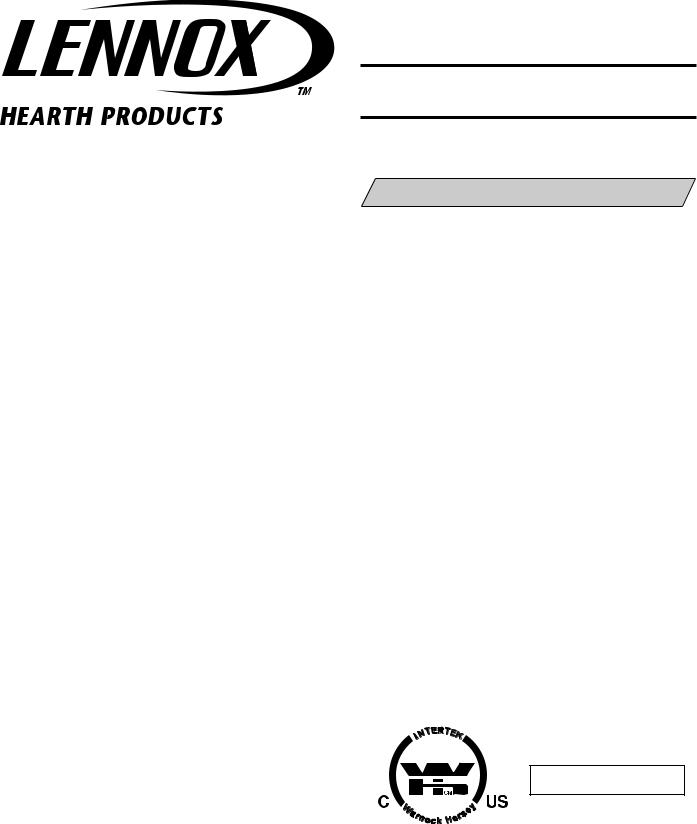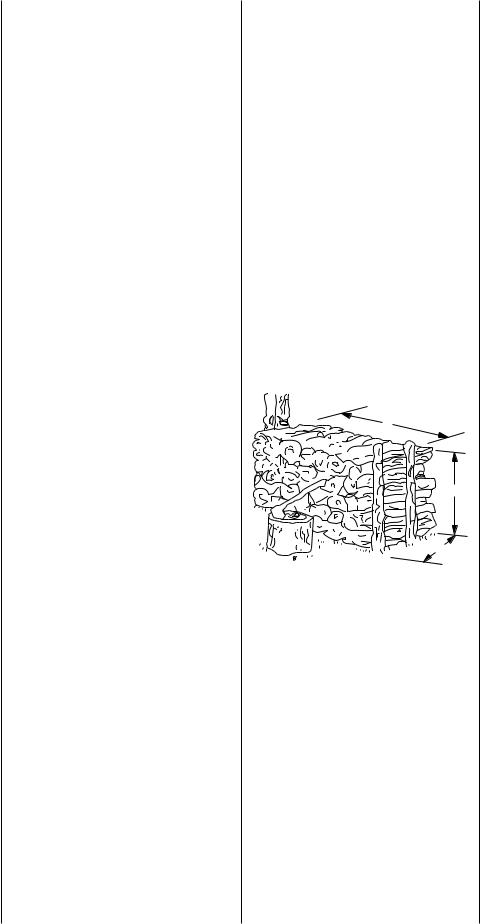Lennox LBR-3824-H, LBC-4324-H, LBR-3824, LBC-3824, LBC-4324 User Manual
...
HOMEOWNER'S CARE AND OPERATION INSTRUCTIONS
ELITE SERIES
38" & 43" Wood Burning Fireplaces P/N 875,003M REV. B 08/2005
MODELS
LBR-3824 LBR-3824-H LBR-4324 LBR-4324-H
LBC-3824 LBC-3824-H LBC-4324 LBC-4324-H
The information contained in this manual applies to all model fireplaces identified on this page. This information will help you obtain safe and dependable service from your Lennox fireplace system. Keep this document in a safe place for future reference.
Before you start your first fire, read this Care and Operations Manual carefully to be sure you understand your fireplace system completely. Failure to follow these suggestions could result in hazardous operation or fireplace malfunction, creating a serious potential for personal injury and/ or property damage.
If you have any questions regarding the safe use or operation of your fireplace, contact your local Lennox Dealer or your contractor/builder.
WH Report No. 629-915173A
RETAIN THESE INSTRUCTIONS
FOR FUTURE REFERENCE
NOTE: DIAGRAMS & ILLUSTRATIONS NOT TO SCALE. |
1 |

TABLE OF CONTENTS |
|
|
General Safety Precautions ................ |
page |
2 |
General Information ........................... |
page |
2 |
Fuels .................................................. |
page |
2 |
Gas Logs ........................................... |
page 2 |
|
Disposal of Ashes .............................. |
page |
3 |
Softwood vs Hardwood ..................... |
page 3 |
|
Starting a Fire .................................... |
page |
4 |
Damper Control ................................. |
page 4 |
|
Glass Door Operating Safety |
|
|
Precautions and Instructions ........... |
page |
4 |
Combustion Air ................................. |
page 5 |
|
Refractories ....................................... |
page |
5 |
Maintenance Guidelines ..................... |
page |
6 |
Twice a Year Check-Up ...................... |
page 6 |
|
Creosote Formation and Removal ...... |
page 6 |
|
Troubleshooting ................................ |
page |
6 |
Warranty ............................................ |
page 7 |
|
Product Reference Information ......... |
page |
7 |
Replacement Parts ............................ |
page 7 |
|
Accessory Components ..................... |
page 7 |
|
Replacement Parts List ...................... |
page |
8 |
GENERAL SAFETY PRECAUTIONS IMPORTANT! READ AND UNDERSTAND BEFORE YOUR FIRST FIRE.
1.Use SOLID WOOD only for fuel. It is best to use dry and well seasoned hardwood. Soft woods tend to burn very quickly. Solid scrap construction lumber produces excessive sparks. DO NOT use treated wood, artificial wax based logs, charcoal, coal, trash, driftwood or woods that have been dipped in tar, pitch, pine tar, creosote, etc. Wood products made with synthetic binders, such as plywood, produce abnormally high temperatures and sputtering, smoking fires.
2.NEVER use gasoline, gasoline-type lantern fuel, kerosene, charcoal lighter fluid, or similar liquids to start or “freshen up” a fire in this fireplace. Keep any flammable liquids a safe distance from the fireplace.
3.Keep the chimney damper open while any fire or smoldering embers are present .
4.Never block or restrict the room air intake grille across the bottom front or the warm air outlet grille across the top front of the fireplace.
5.Use care when selecting window treatments for windows located near the fireplace. Avoid using combustible flowing window treatments such as curtains on nearby windows that are of sufficient length to be blown in front of an open flame when the window is opened.
2
6.With the fire burning, close the protective mesh screens to keep sparks and embers INSIDE the firebox.
7.Keep any combustible furniture or decorative pillows at least 36" (914 mm) from the fireplace opening.
8.Never leave your fireplace unattended while it is burning.
9.Be careful adding wood fuel to the fire or handling fireplace tools such as shovels, tongs or pokers.
10.Never modify or alter your fireplace system in any way. To do so may create a potential fire hazard and void the Limited Warranty.
11.The bottom refractory can be cracked by excessive abuse such as tossing heavy logs onto the grate or gouging with fireplace tools. Exercise caution when adding wood to your fireplace.
12.DO NOT use a fireplace insert or any other product not specified by the manufacturer for use with this fireplace.
13.If you are using your fireplace as a “decorative appliance,” such as with a permanently installed gas log set, the fireplace damper must be permanently fixed in the open position. Listed “vent-free” gas log sets may be used with the damper closed.
14.Always ensure that an adequate supply of replacement combustion air from the outside of the house is accessible to the fire to support normal combustion. Fireplaces consume large volumes of air during the normal combustion process. In the event the home is tightly sealed with modern energy efficient features, the optional combustion air kit may not provide all the air required to support combustion. Neither the manufacturer nor the seller are responsible for any smoking or related problems that may result from the lack of adequate combustion air. It is the responsibility of the builder/contractor to ensure that adequate combustion air has been provided for the fireplace.
15.Neither the manufacturer nor the seller warrants "smoke free" operation nor are they responsible for inadequate system draft caused by mechanical systems, general construction conditions, inadequate chimney heights, adverse wind conditions and/or unusual environmental factors or conditions beyond our control.
NOTE: DIAGRAMS & ILLUSTRATIONS NOT TO SCALE.
GENERAL INFORMATION
1.The all-steel, multi-wall firebox is the heat center of the system. It is well insulated for safe clearance to combustibles.
2.The hearth floor and sidewalls of the firebox are lined with a brick pattern reinforced refractory for the look of authenticity and to provide safety.
3.The metal chimney sections extending from the firebox top to beyond your roof are two walled and air-cooled. The inner passage, or flue, provides the exit for smoke and gases.
4.The flue damper is a two position (fully open or fully closed) mechanism operated by a handle found at the center top of the fireplace opening. It must be open when fire is present so smoke and gases can escape. It should be closed ONLY when the fire is completely out – keeping room air from being lost up the flue.
5.Closed screens prevent fire, sparks and embers from popping out of the firebox while a fire is burning. Pull screens back when adding wood to the firebox.
6.Why use a fuel grate? Besides positioning the firebed properly, it protects the refractory floor, back and sides of the fireplace. Further, it ensures a proper flow of combustion air into and around the firebed. The grate must be used at all times when burning. Your warranty may be voided without the use of this grate.
7.Remember, your fireplace is not intended to heat your entire home.
FUELS
Never Use Coal in Your Fireplace
Your fireplace system is not designed to be used with coal derivative products. The combustion process of certain types of coal can deposit corrosive materials in the fireplace and chimney system which can lead to premature product failure. Never use coal as a fuel in this fireplace system.
Gas Logs
If your fireplace system was installed with a gas line, you may wish to install one of two types of gas log sets.

This fireplace has been tested and approved for use with a decorative gas appliance incorporating an automatic shut-off device and complying with the Standard for Decorative Gas Appliances for installation in vented fireplaces, ANSI Z21.60 (1991). Decorative gas appliances may be installed in these fireplaces. Installation must be in accordance with the national Fuel Gas Code, ANSI Z223.1 for compliance with the revised U.L. 127 Standard.
CAUTION: WHEN USING A DECORATIVE GAS APPLIANCE, THE FIREPLACE DAMPER MUST BE SET TO THE FULLY OPEN POSITION.
These fireplaces have been tested and approved to ANSI/IAS/AGA Z21.11.2 for use with an unvented gas appliance having a maximum rating of 40,000 BTU and complies with the Standard for Factory-Built Fireplaces, U.L. 127, when installed with unvented gas log sets.
Prior to installing any gas log set, (Vented or Unvented) refer to the fireplace installation instructions for verification of mantle heights and placement of combustible materials around the firebox opening. NEVER INSTALL AN
UNVENTED GAS LOG SET WITH A BTU RATING GREATER THAN 40,000 BTU. Vented gas log sets do not have restrictions placed upon their BTU rating.
Wood Fuel Pointers
Wood is a wonderful renewable fuel source. Normally it burns clean, leaving only a minimum of waste ash, provides comforting heat and can provide a variety of aromas and visual images.
You will want to know which woods are best for use. Sometimes you may want a quick, short fire to offset a morning chill. Soft woods are preferable in this case. Other times you would want more slow burning and a uniform heat output. Hardwoods are preferable for this use.
The amount of heat available from the logs will be about equal on a weight basis. However, logs are generally not weighed so the amount of heat will depend on:
1.The type of wood used.
2.How dry it is.
3.How many logs you put in.
4.The size of the logs.
The last statement means that one big log weighing 10 pounds has as much heating potential as 10 pounds of twigs. However, air cannot get at the solid log to feed the fire so the solid log will burn slowly. While you would get the same amount of heat out of either fire, the smaller the pieces of wood and the more air space around them, the faster the fire will burn.
DISPOSAL OF ASHES
Ashes should be placed in a metal container with a tight fitting lid. The closed container of ashes should be placed on a noncombustible floor or on the ground, well away from all combustible materials, pending final disposal. If the ashes are to be disposed of by burial in soil or other wise locally dispersed, they should be retained in the closed container until all cinders have thoroughly cooled.
SOFTWOOD VS HARDWOOD
Softwoods contain about 15 percent highly flammable resin which generates creosote soot in the chimney flue. Burning softwood exclusively may not be as desirable nor as safe as burning denser hardwoods. Many experienced fire-builders use small amounts of softwood kindling and newspaper in conjunction with starting a fire with split hardwood logs. Here are some guidelines to remember:
1.Softwoods produce fast warming and shorter fires. Hardwoods burn less vigorously, have shorter flames and produce steady, glowing coals.
2.As a general rule, denser woods contain more potential heat per pound. Most softwoods offer moderate heat value per pound.
3.Different woods vary widely in flame heights, flame intensities, smoke characteristics and in sparking. Most hardwoods do not spark.
4.Most freshly cut “green” wood will not burn well and will smoke. Green wood can be from
10to 40 percent less efficient than air-dried seasoned wood.
5.Moisture and resin found inside unseasoned wood cells will build up pressure under heat and explode as sparks.
NOTE: DIAGRAMS & ILLUSTRATIONS NOT TO SCALE.
6.Most wood needs to be seasoned 9 to 12 months to reduce the moisture content and produce good steady fires. When moisture content is reduced from 60 to 20%, the gain in heat potential is nearly 7%.
7.Proper storage of wood, especially during seasoning, is essential. We recommend that you:
a.Never store wood on the ground. This will cause rotting and insect infiltration. Raise wood on flat rock or scrap wood.
b.Stack wood loosely to allow air circulation.
c.Store wood where it will not be excessively exposed to weather, such as under a tarp or under a roof.
d.Do not stack wood directly against the walls of your home.
8. Be a knowledgeable wood buyer. There is a difference in cord sizes. A standard cord stack of logs is 4 ft. high by 8 ft. long by 4 ft. deep or the equivalent of this cubic footage, (Figure 1 ).
|
Standard |
8' |
Cord of |
Wood |
4'
4'
Figure 1
A face cord is the same height and length as a standard cord but the depth is only the length of the logs (12, 18 or 24 inches). A face cord can contain as little as 25% of the wood found in a standard cord.
If you buy by the ton, remember that wood becomes lighter as it dries. When buying green or wet wood, ask for some extra poundage to allow for the extra water you will be getting.
9. When comparing woods of the same moisture content and same species, we find most woods have approximately the same heating potential per pound.
3
